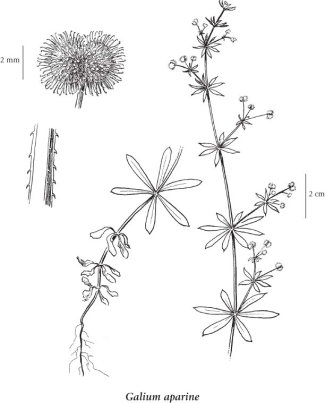cleavers (stickywilly)
Rubiaceae (Madder family)
Introduction to Vascular Plants
Species Information click to expand contents
General:
Annual herb from a taproot; stems weak, climbing or prostrate, solitary, few branched, square, short-hairy on the angles, the hairs pointed downwards, 10-100 cm tall/long.
Leaves:
Basal leaves few, soon deciduous; stem leaves in whorls of 8 (sometimes 6), narrowly oblanceolate, 1-4 (7) cm long, lowermost stalked, upper ones unstalked, entire, awn-tipped, 1-veined, bristly-hairy along the margins, bristly-hairy above, with hooked hairs, the hairs pointed backwards.
Flowers:
Inflorescence of 3-5, stalked, terminal flowers on branchlets in most leaf axils; corollas saucer-shaped, white, 1.6-2 mm wide, 4-lobed; calyces obsolete.
Fruits:
Nutlets, 2, 3-5 mm wide, with numerous, short, hooked hairs.
Illustration click to expand contents

If more than one illustration is available for a species (e.g., separate illustrations were provided for two subspecies) then links to the separate images will be provided below. Note that individual subspecies or varietal illustrations are not always available.
Illustration Source: The Illustrated Flora of British Columbia
USDA Species Characteristics click to expand contents
Flower Colour:
Green
Blooming Period:
Mid Spring
Fruit/Seed characteristics:
Colour: Brown
Present over the Spring
Source: The USDA
Ecology click to expand contents
The table below shows the species-specific information calculated from
original data (BEC database) provided by the BC Ministry of Forests and Range.
(Updated August, 2013)
| Site Information |
Value / Class |
||
|
Avg |
Min |
Max |
|
| Elevation
(metres) |
472 | 0 | 1710 |
| Slope
Gradient (%) |
29 | 0 | 135 |
|
Aspect (degrees) |
203 | 20 | 360 |
| Soil
Moisture Regime (SMR) [0 - very xeric; 4 - mesic; 8 - hydric] |
3 | 0 | 8 |
| Modal
Nutrient Regime
Class |
C | ||
| #
of field plots species was recorded in: |
270 | ||
| Modal
BEC Zone Class |
CDF | ||
|
All BEC Zones (# of stations/zone) species was recorded in |
BG(4), CDF(110), CMA(1), CWH(52), ESSF(13), ICH(25), IDF(20), MH(1), MS(9), PP(11), SBS(1) | ||
|
Source:
Klinkenberg 2013
|
|||
Habitat and Range click to expand contents
Status Information click to expand contents
Synonyms click to expand contents
Synonyms and Alternate Names:
Galium agreste var. echinospermum Wallr.
Galium aparine subsp. spurium (L.) Simonkai
Galium aparine var. echinospermum (Wallr.) Farw.
Galium aparine var. intermedium (Merr.) Briq.
Galium aparine var. minor Hook.
Galium aparine var. vaillantii (DC.) Koch
Galium spurium var. echinospermum (Wallr.) Hayek
Galium spurium var. vaillantii (DC.) G. Beck
Galium vaillantii DC.
Taxonomic Notes click to expand contents
There is debate as to the origin status of this species. While some consider it native to North America, some feel it is introduced. It is possible it is native but that it has also been introduced from Europe (Gucker 2005).
References Gucker, Corey L. 2005. Galium aparine. In: Fire Effects Information System, [Online]. U.S. Department of Agriculture, Forest Service, Rocky Mountain Research Station, Fire Sciences Laboratory (Producer). Available Online. |